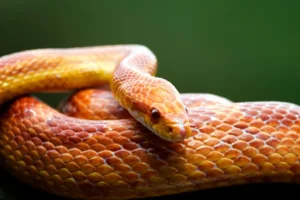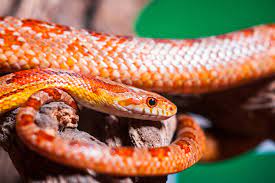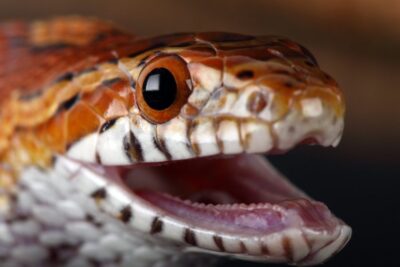Curiosity often leads us to probe the intricacies of the animal kingdom, and one common question that arises among reptile enthusiasts is, “Does a corn snake have teeth?” As one delves into the world of these captivating serpents, understanding their dental anatomy becomes a fascinating exploration.
Yes, corn snakes do indeed have teeth. They possess small, recurved teeth which line their upper and lower jaws. These teeth are used for gripping and holding onto prey while they constrict it before swallowing. While not venomous, the teeth of corn snakes are effective tools for aiding in their feeding process.
Anatomy of a Corn Snake Teeth

Corn snakes, like many other non-venomous snakes, have a relatively simple dental structure compared to venomous snakes. Here’s an overview of the anatomy of a corn snake’s teeth:
- Dentition: Corn snakes have two main types of teeth: recurved teeth (rearward-facing) and fixed teeth (frontward-facing). Recurved teeth are primarily used for gripping and holding prey, while fixed teeth help in swallowing and manipulation.
- Shape and Size: Corn snake teeth are relatively small and slender compared to those of larger constrictors or venomous snakes. They typically have a slightly curved shape, with a pointed tip for puncturing and holding onto prey.
- Location: The teeth are arranged in rows along the upper and lower jaws of the snake. Corn snakes have several rows of teeth, with the outer rows being functional and the inner rows serving as replacements. As teeth are lost or damaged, they are continuously replaced throughout the snake’s life.
- Function: Corn snake teeth play a crucial role in capturing, immobilizing, and consuming prey. When hunting, the snake strikes at its prey and uses its recurved teeth to grasp and secure it. Once the prey is subdued, the snake maneuvers it into a position where it can swallow it whole, using its fixed teeth to assist in guiding the prey down its throat.
- No Venom: Unlike venomous snakes, corn snakes do not possess venom glands or specialized fangs for injecting venom. Instead, their teeth rely solely on physical force to capture and restrain prey.
Understanding the anatomy of a corn snake’s teeth provides insight into its feeding behavior and how it interacts with its environment.
Types of teeth found in snakes
Snakes have a variety of teeth specialized for different functions, depending on their diet and hunting strategies. Here are the main types of teeth found in snakes:
- Fangs:
- Front Fangs: Fangs are elongated, hollow teeth located in the front of the upper jaw. Venomous snakes, such as vipers, cobras, and rattlesnakes, have specialized front fangs used for injecting venom into prey or predators. These fangs can be either fixed or hinged, depending on the species.
- Maxillary Teeth:
- Recurved Teeth: Found in the upper jaw, these teeth are typically recurved (curved backward) and are used for grasping and holding prey. They help in preventing the prey from escaping.
- Fixed Teeth: These teeth are also located in the upper jaw and are usually smaller and less curved compared to recurved teeth. They assist in guiding prey into the snake’s throat during swallowing.
- Mandibular Teeth:
- Similar to Maxillary Teeth: Snakes also have teeth in their lower jaw, which serve similar functions to those in the upper jaw. Mandibular teeth can be recurved or fixed, aiding in prey capture and manipulation.
- Replacement Teeth:
- Snakes continuously shed and replace their teeth throughout their lives. Replacement teeth are present in multiple rows behind the functional teeth. As teeth are lost or damaged, new teeth move forward to take their place. This ensures that the snake maintains an effective set of teeth for hunting and feeding.
- Reduced or Absent Teeth:
- Some snake species, particularly those with highly specialized diets such as fish-eating snakes, may have reduced or absent teeth. Instead, they rely on other adaptations, such as specialized jaws or digestive systems, to capture and consume their prey.
Understanding the diversity of teeth in snakes helps in comprehending their feeding ecology, hunting strategies, and evolutionary adaptations.
Corn Snake Dental Structure
Corn snakes, like many non-venomous colubrid snakes, have a relatively simple dental structure compared to venomous snakes. Here’s an overview of the dental structure of a corn snake:
- Teeth Types:
- Corn snakes have two main types of teeth: recurved teeth and fixed teeth.
- Recurved Teeth: These teeth are located towards the back of the upper and lower jaws and are typically curved backward (recurved). They are used for grasping and holding onto prey.
- Fixed Teeth: Fixed teeth are located towards the front of the upper and lower jaws and are usually smaller and less curved compared to recurved teeth. They assist in swallowing and manipulation of prey.
- Arrangement:
- The teeth are arranged in rows along the upper and lower jaws of the snake.
- Corn snakes have several rows of teeth, with the outer rows being functional and the inner rows serving as replacements.
- As teeth are lost or damaged, new teeth continuously move forward to replace them throughout the snake’s life.
- Function:
- Corn snake teeth play a crucial role in capturing, immobilizing, and consuming prey.
- When hunting, the snake strikes at its prey and uses its recurved teeth to grasp and secure it.
- Once the prey is subdued, the snake maneuvers it into a position where it can swallow it whole, using its fixed teeth to assist in guiding the prey down its throat.
- Absence of Venom:
- Unlike venomous snakes, corn snakes do not possess specialized venom glands or fangs for injecting venom into their prey.
- Instead, they rely on constriction and physical force to capture and subdue their prey.
Understanding the dental structure of a corn snake provides insights into its feeding behavior and how it interacts with its environment.
Functions of Corn Snake Teeth

The teeth of a corn snake serve several important functions related to its feeding behavior and survival. Here are the key functions of corn snake teeth:
- Capturing Prey: Corn snake teeth are essential for capturing prey. The recurved teeth, located toward the back of the upper and lower jaws, are designed to grasp and hold onto prey effectively. When hunting, the snake strikes at its prey and uses its teeth to secure it, preventing the prey from escaping.
- Immobilizing Prey: Once the prey is grasped by the teeth, the corn snake may use constriction to further immobilize it. Although corn snakes are not constrictors like some other snake species, they may still use their teeth in combination with body coils to help control and immobilize their prey.
- Swallowing Prey: After capturing and immobilizing its prey, the corn snake uses its teeth to manipulate the prey into a position suitable for swallowing. The fixed teeth, located toward the front of the upper and lower jaws, help guide the prey into the snake’s throat during swallowing.
- Assisting in Digestion: While the primary function of corn snake teeth is related to prey capture and swallowing, they may also play a role in digestion. By manipulating and breaking down prey items with their teeth before swallowing, corn snakes may facilitate the digestive process.
- Replacing Lost Teeth: Corn snakes continuously shed and replace their teeth throughout their lives. The presence of replacement teeth ensures that the snake maintains an effective set of teeth for hunting and feeding even if some are lost or damaged. As teeth are lost, new teeth move forward to take their place, ensuring a continuous supply of functional teeth.
Overall, the teeth of a corn snake are specialized structures that play a crucial role in capturing, immobilizing, and consuming prey, as well as in maintaining the snake’s overall health and survival in its natural habitat.
Importance of Corn Snake Teeth to Their Survival
Corn snakes, like many other snakes, rely heavily on their teeth for survival. Here’s why their teeth are important:
- Hunting and Feeding: Corn snakes are carnivores, primarily preying on small rodents like mice and rats. Their teeth are essential for grasping and holding onto their prey while they constrict it. Without their teeth, they would struggle to capture and consume their food effectively, leading to starvation and eventual death.
- Defense: While corn snakes are non-venomous and typically docile, they still need their teeth for defense. When threatened, they may strike to deter predators or humans. Their teeth help in delivering these defensive bites, deterring potential threats and allowing them to escape danger.
- Constriction: Corn snakes, like many other constrictor species, use constriction as a method of subduing their prey. They wrap their bodies around the prey item and tighten their coils, suffocating it. Their teeth play a crucial role in holding onto the prey during this process, ensuring it cannot escape.
- Handling Prey: After capturing their prey, corn snakes need their teeth to manipulate and position it for consumption. Their teeth help in gripping and maneuvering the prey into a position where they can swallow it whole.
- Digestion: While not directly related to their teeth, the process of swallowing prey whole relies on the teeth to initially grasp the prey. Once swallowed, the prey is moved through the snake’s digestive system, where it is broken down and absorbed as nutrients, contributing to the snake’s overall survival and well-being.
Overall, the teeth of corn snakes are crucial adaptations that allow them to effectively hunt, defend themselves, and consume prey, all of which are essential for their survival in their natural habitat.
Care and Maintenance of Corn Snake Teeth
Corn snake teeth, like those of all snakes, are essential for their survival and well-being. While they don’t require as much direct care as other aspects of snake husbandry, maintaining overall snake health indirectly supports the health of their teeth. Here are some considerations for ensuring the care and maintenance of corn snake teeth:
- Proper Diet: Providing a balanced and appropriate diet is crucial for maintaining healthy teeth. Feeding your corn snake a diet of appropriately sized prey, such as mice or rats, ensures they can exercise their teeth and keep them sharp. In captivity, it’s essential to offer pre-killed prey to prevent injury to the snake during feeding.
- Habitat Maintenance: Keeping the snake’s enclosure clean and properly maintained reduces the risk of bacterial and fungal infections, which can affect the snake’s overall health, including its teeth. Regularly clean the enclosure, remove any uneaten food promptly, and provide clean water for drinking.
- Preventative Healthcare: Regular veterinary check-ups are essential for monitoring the overall health of your corn snake, including their teeth. A veterinarian experienced with reptiles can identify any dental issues early on and provide appropriate treatment if necessary.
- Environmental Enrichment: Providing environmental enrichment in the form of climbing branches, hiding spots, and other features in the snake’s enclosure encourages natural behaviors, including chewing and exploring. These activities help maintain dental health by promoting natural wear and tear on the teeth.
- Avoiding Injury: Be mindful of any objects within the snake’s enclosure that could potentially cause dental injury, such as sharp or abrasive materials. Additionally, handle your corn snake gently and avoid actions that could stress or injure them, which could indirectly affect their dental health.
- Observation: Regularly observe your corn snake for any signs of dental issues, such as broken or discolored teeth, swelling or redness around the mouth, or changes in eating behavior. Early detection of dental problems allows for prompt veterinary intervention.
While direct dental care for corn snakes is minimal compared to other pets, maintaining their overall health and providing a suitable environment is crucial for ensuring the health and longevity of their teeth. By following these care guidelines, you can help keep your corn snake’s teeth healthy and functional throughout their life.
Tips for promoting oral health in pet corn snakes
Promoting oral health in pet corn snakes is essential for their overall well-being. Here are some tips to help maintain good oral hygiene in your pet corn snake:
- Provide a Balanced Diet: Offer a varied diet of appropriately sized prey items, such as mice or rats, to ensure your corn snake receives essential nutrients. Providing whole prey items helps exercise their jaw muscles and promotes natural dental wear.
- Feed Pre-Killed Prey: Avoid live prey to prevent potential injuries to your snake’s mouth during feeding. Pre-killed prey is safer and reduces the risk of dental damage from struggling prey.
- Monitor Feeding: Be mindful of any difficulties your corn snake may have when eating, such as struggling to grasp or swallow prey. If you notice any issues, consult a veterinarian to assess your snake’s dental health and address any potential problems.
- Maintain Proper Enclosure Conditions: Keep the snake’s enclosure clean and at appropriate humidity and temperature levels. Proper environmental conditions support overall health, including dental health.
- Provide Environmental Enrichment: Include objects such as climbing branches, hiding spots, and textured surfaces in the enclosure to encourage natural behaviors, including chewing. These activities help promote dental health by facilitating natural wear on the teeth.
- Regular Health Checks: Schedule regular veterinary check-ups to monitor your corn snake’s overall health, including their oral health. A veterinarian experienced with reptiles can detect and address any dental issues early on.
- Observe Oral Health: Regularly check your corn snake’s mouth for signs of dental problems, such as broken or discolored teeth, swelling, or redness. Any abnormalities should be promptly addressed by a veterinarian.
- Handle with Care: Handle your corn snake gently and avoid actions that could stress or injure them, including forceful handling or aggressive interactions with other pets. Stress and injuries can indirectly impact dental health.
- Provide Clean Water: Ensure your corn snake always has access to clean, fresh water for drinking. Hydration is essential for overall health, including oral health.
- Educate Yourself: Stay informed about proper corn snake care practices, including dental health, by consulting reputable sources such as books, websites, or experienced reptile keepers. Continuously educate yourself to provide the best possible care for your pet.
By following these tips, you can help promote good oral health and overall well-being in your pet corn snake. Regular care and attention to their dental health contribute to a happy and healthy life for your snake.
Conclusion
The information above highlights the fascinating features of corn snakes and their distinctive dental anatomy. While commonly mistaken for venomous, corn snakes possess teeth specialized for grasping and consuming prey, not for injecting venom.
Understanding their dental structure enriches our appreciation of these captivating creatures and dispels misconceptions surrounding their harmless nature. Therefore, the answer to “Does a corn snake have teeth?” is a resounding yes, but rest assured, they pose no threat to humans.

